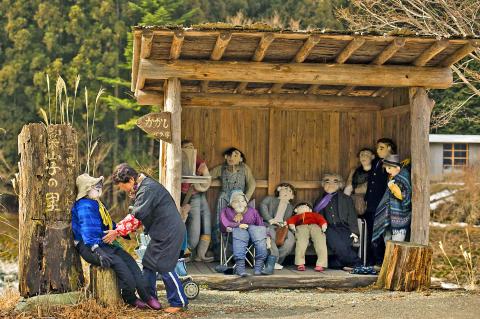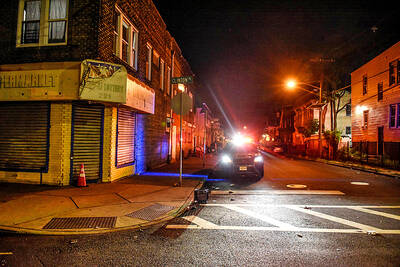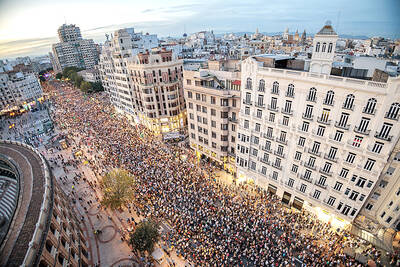Tsukimi Ayano made her first scarecrow 13 years ago to frighten off birds pecking at seeds in her garden.
The life-sized straw doll resembled her father, so she made more, and then could not stop.
Today, the tiny village of Nagoro in southern Japan is teeming with Ayano’s hand-sewn creations, frozen in time for a tableau that captures the motions of everyday life.

Photo: Reuters
Scarecrows pose in houses, fields, trees, streets and at a crowded bus stop — where they wait for a bus that never comes.
“In this village, there are only 35 people, but there are 150 scarecrows, so it’s multiple times more,” Ayano said.
Nagoro, like many villages in Japan’s countryside, has been hit hard by inhabitants flocking to cities for work and leaving mostly pensioners behind. Its graying community is a microcosm of Japan, whose population has been falling for a decade and is projected to drop from 127 million to 87 million by 2060.
At 65, Ayano is among the youngest residents of Nagoro. The village school was shut in 2012 after its two pupils graduated, but the building is now occupied by Ayano’s scarecrows — students at their desks and in corridors, a teacher by the blackboard, while a suit-wearing school principal looks on.
Each of the 350 scarecrows crafted by Ayano over the years was built on a wooden base, with newspapers and cloth used to fill them out. They are often dressed in hand-me-downs and the ones propped up outdoors lined with plastic to keep them dry.
Still, the weather plays spoilsport and Ayano has often had to replace scarecrows exposed to the open air.
Sometimes, the new ones she makes are made to order, usually in the likeness of young people who have left Nagoro for work or residents who have died.
“They’re created as requests for those who’ve lost their grandfather or grandmother,” said Osamu Suzuki, a 68-year-old resident. “So it’s indeed something to bring back memories.”
Tourists have started to come, too, drawn by the two lifeless delegates guarding the road leading to the village, next to a board identifying Nagoro as “Scarecrow Village.”
Ayano is happy to show her work to visitors, as long as she is not disturbed while watching her favorite TV soap opera. On her daily rounds, she walks around the village bidding her motionless creations a good morning and tends to their needs.

DOUBLE-MURDER CASE: The officer told the dispatcher he would check the locations of the callers, but instead headed to a pizzeria, remaining there for about an hour A New Jersey officer has been charged with misconduct after prosecutors said he did not quickly respond to and properly investigate reports of a shooting that turned out to be a double murder, instead allegedly stopping at an ATM and pizzeria. Franklin Township Police Sergeant Kevin Bollaro was the on-duty officer on the evening of Aug. 1, when police received 911 calls reporting gunshots and screaming in Pittstown, about 96km from Manhattan in central New Jersey, Hunterdon County Prosecutor Renee Robeson’s office said. However, rather than responding immediately, prosecutors said GPS data and surveillance video showed Bollaro drove about 3km

Tens of thousands of people on Saturday took to the streets of Spain’s eastern city of Valencia to mark the first anniversary of floods that killed 229 people and to denounce the handling of the disaster. Demonstrators, many carrying photos of the victims, called on regional government head Carlos Mazon to resign over what they said was the slow response to one of Europe’s deadliest natural disasters in decades. “People are still really angry,” said Rosa Cerros, a 42-year-old government worker who took part with her husband and two young daughters. “Why weren’t people evacuated? Its incomprehensible,” she said. Mazon’s

‘MOTHER’ OF THAILAND: In her glamorous heyday in the 1960s, former Thai queen Sirikit mingled with US presidents and superstars such as Elvis Presley The year-long funeral ceremony of former Thai queen Sirikit started yesterday, with grieving royalists set to salute the procession bringing her body to lie in state at Bangkok’s Grand Palace. Members of the royal family are venerated in Thailand, treated by many as semi-divine figures, and lavished with glowing media coverage and gold-adorned portraits hanging in public spaces and private homes nationwide. Sirikit, the mother of Thai King Vajiralongkorn and widow of the nation’s longest-reigning monarch, died late on Friday at the age of 93. Black-and-white tributes to the royal matriarch are being beamed onto towering digital advertizing billboards, on

POWER ABUSE WORRY: Some people warned that the broad language of the treaty could lead to overreach by authorities and enable the repression of government critics Countries signed their first UN treaty targeting cybercrime in Hanoi yesterday, despite opposition from an unlikely band of tech companies and rights groups warning of expanded state surveillance. The new global legal framework aims to bolster international cooperation to fight digital crimes, from child pornography to transnational cyberscams and money laundering. More than 60 countries signed the declaration, which means it would go into force once ratified by those states. UN Secretary-General Antonio Guterres described the signing as an “important milestone,” and that it was “only the beginning.” “Every day, sophisticated scams destroy families, steal migrants and drain billions of dollars from our economy...